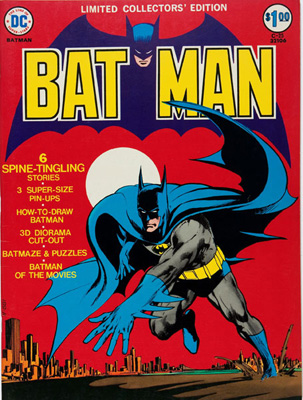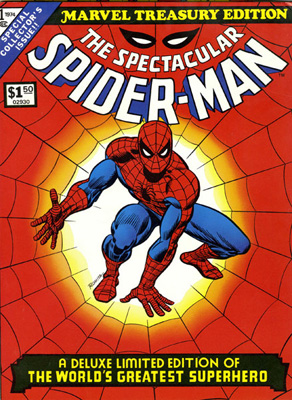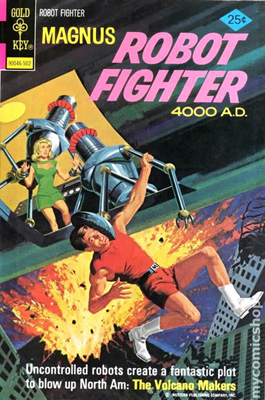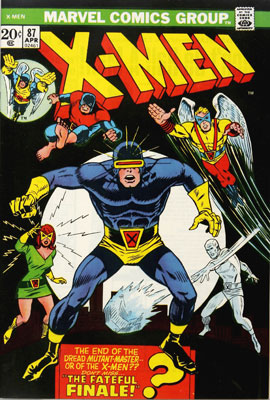LINKS
- Attack of the 50-Year-Old Comics
- Super-Team Family: The Lost Issues
- Mark Evanier's Blog
- Plaid Stallions
- Star Trek Fact Check
- The Suits of James Bond
- Wild About Harry (Houdini)
The first time I ever read a comic book was almost certainly before 1974, but in that year — my ninth year here on Earth-Prime — no trip to the local pharmacy or grocery store was complete without a stop at the creaky, spinning spindle racks that served up comics by the dozens, from humor to superheroes, war stories to westerns, horror to romance. If I was really lucky — and if I’d stayed mostly out of trouble the previous week — I could usually beg enough change off my folks to buy a few of these four-color treasures (so much better than Pixie Stix or bubblegum, which were gone in mere minutes!). Then it was a matter of reading and re-reading them until the images were burned forever into my brain.
 For instance, there was the cover of Superman #274, drawn by the late great Nick Cardy and like most Superman covers tons more exciting than the story inside. On this one, Superman is reaching out to the reader (me!) pleading for help as his lower body is stretched impossibly thin and sucked through the planet Earth. With his left hand, he clings desperately to the books’ logo, crushing it in his super-grip. Maybe there was a kid out there who could resist that kind of brilliant salesmanship, but whoever it was, he was stronger willed than I.
For instance, there was the cover of Superman #274, drawn by the late great Nick Cardy and like most Superman covers tons more exciting than the story inside. On this one, Superman is reaching out to the reader (me!) pleading for help as his lower body is stretched impossibly thin and sucked through the planet Earth. With his left hand, he clings desperately to the books’ logo, crushing it in his super-grip. Maybe there was a kid out there who could resist that kind of brilliant salesmanship, but whoever it was, he was stronger willed than I.
But if Superman was the early favorite, possibly because he wormed his way into my consciousness through cartoons and live-action TV, Batman soon eclipsed him. Drawn regularly by the likes of Neal Adams, Jim Aparo and Irv Novick, on occasion by Walt Simonson or Bernie Wrightson and in time by Marshall Rogers and Michael Golden, the darknight detective was a magnet for the best artists in the business. While Superman and his god-like ilk threw mountains at each other, Batman was a flesh-and-blood human who could be knocked out, beaten up, potentially even killed by things as mundane as poison, knives, guns, long falls, speeding cars…basically anything that could kill you or me. That certainly made it a lot easier to create dramatic situations to build stories around. Plus he could be made to work in almost any type of story. For instance, 1974 saw an obsession with horror and the supernatural, thanks to then-recent movies like the Excorcist and Rosemary’s Baby (and that summer, Jaws). You could throw Batman into a horror story and have it work — in fact that’s where his roots were, as I would later learn — whereas no ghosts or goblins could possibly raise a goosebump when pitted against the brightly colored, invulnerable Man of Steel. Batman had a “vampire” vibe going with those pointy ears and a swirling cape that, depending on who drew it, might billow out as huge as a ship’s sail. It was this creepy, borderline supernatural take on the character — despite the contemporaneous Super-Friends version and reruns of Adam West — that most shaped my view of Batman.
 If I had to pick a single Batman comic from 1974 to name “most memorable” — and it would be difficult — I’d have to go with Limited Collector’s Edition C-26, a decidedly boring and nondescript name for a spectacular-looking book. This was the first “tabloid” comic I ever saw; tall as an old LIFE magazine, with cardstock covers and a collection of stories from various eras, topped off with a wonderfully garish red cover with a Neal Adams-drawn image lifted from Batman #251 and destined to re-appear innumerable times on merchandise of every kind for decades to come. On the back cover was a “3-D Diorama” of Batman leaping onto some bad guys: we were encouraged to cut it out and assemble it for display on a tabletop, and that’s just what I did (who wants to get rich off a “mint condition” comic, anyway?).
If I had to pick a single Batman comic from 1974 to name “most memorable” — and it would be difficult — I’d have to go with Limited Collector’s Edition C-26, a decidedly boring and nondescript name for a spectacular-looking book. This was the first “tabloid” comic I ever saw; tall as an old LIFE magazine, with cardstock covers and a collection of stories from various eras, topped off with a wonderfully garish red cover with a Neal Adams-drawn image lifted from Batman #251 and destined to re-appear innumerable times on merchandise of every kind for decades to come. On the back cover was a “3-D Diorama” of Batman leaping onto some bad guys: we were encouraged to cut it out and assemble it for display on a tabletop, and that’s just what I did (who wants to get rich off a “mint condition” comic, anyway?).
These oversized comics were a huge hit with me and Marvel’s version of the format accounted for, as near as I can tell, almost all the Marvel Comics I bought in 1974. In a million playground arguments over which heroes were best, I always picked DC over Marvel, but it wasn’t that I disliked the Marvel characters, per se: in fact, I thought Spider-Man had possibly the coolest costume of any superhero, and Captain America was the bomb. No, the problem was that no Marvel comic ever seemed to have a beginning or an ending; they started in the middle of a story and ended in a cliffhanger. Nowadays the “serialized storytelling” approach has been adopted by every publisher, but at the time it struck me as slightly shady, taking my 20 cents and not giving me a whole story. That, combined with the tone of “Stan’s Soapbox” and the little text adverts that ran across the bottom of every page struck me as vulgar hucksterism; to me, Stan Lee was like the carnival barker who promised you a peek at the dog-faced boy or the Fiji Mermaid; amusing in his way, but not to be trusted.
 Moral posturing aside, it was really came down to simple pragmatism: living in the boonies as I did, with no guarantee I’d even get to go along on those weekly trips into town, there was no way I could count on finding two consecutive issues of any comic, no matter how much I might like it. So it just didn’t make sense to buy, say, Iron Man in a given month when it was more than likely I’d never find out how he got out of the pickle he found himself in at the end of the issue.
Moral posturing aside, it was really came down to simple pragmatism: living in the boonies as I did, with no guarantee I’d even get to go along on those weekly trips into town, there was no way I could count on finding two consecutive issues of any comic, no matter how much I might like it. So it just didn’t make sense to buy, say, Iron Man in a given month when it was more than likely I’d never find out how he got out of the pickle he found himself in at the end of the issue.
The tabloids, however, were divorced from the constraints of monthly continuity, being essentially “best of” collections that cherry-picked particularly memorable stories for reprinting. Plus, like their DC counterparts, they had some truly awesome covers. Marvel Treasury Edition #1, starring Spider-Man, was a prime example, with a dazzlingly colored illo of Spidey by the great John Romita.
Not everything was about DC and Marvel, though. There was the slightly off-kilter universe of Gold Key comics, featuring “almost but not quite right” takes on Bugs Bunny, Bullwinkle and the Pink Panther and an unfathomably clueless version of Star Trek, where every character spoke and acted completely out of character, wearing costumes that kinda-sorta resembled designs seen only in the pilot, living on an Enterprise with a bridge that looked like a 1930’s auto factory and huge plumes of flame shooting out of its warp nacelles. With the show more popular in 70s syndication than it ever had been on network TV — indeed as a bona-fide cultural phenomenon — it always seemed incredible that the only people in the world who had no clue about the characters, technologies and backstory of Star Trek were the writers and artists chosen to create the comics.
 There was one case where the daft sensibilities of Gold Key worked well, though, and that was in the pages of Magnus: Robot Fighter, a comic built around the loopy concept of a futuristic muscleman whose sole purpose in life was to punch, kick and karate chop rampaging robots into scrap metal. I’ve seen Magnus described as a sort of future Tarzan, and I guess that’s fair enough; there’s certainly a beefcake angle as he dashes around with bare arms and legs, although it’s more than compensated for by his girlfriend Leeja, whose va-va-voom figure is barely concealed by a skintight nightgown-type outfit seemingly fashioned out of tinted saran wrap. In fact, Magnus artist Russ Manning drew the Tarzan newspaper strip for years, so there’s that connection if nothing else. “Guy punches robots” seems like a pretty flimsy premise for an ongoing title, but it’s hard to deny the obvious appeal to the average American boy, especially in the days of “Rock-Em, Sock-Em” robots, when we could still pretend we were the masters of the machines and not the reverse.
There was one case where the daft sensibilities of Gold Key worked well, though, and that was in the pages of Magnus: Robot Fighter, a comic built around the loopy concept of a futuristic muscleman whose sole purpose in life was to punch, kick and karate chop rampaging robots into scrap metal. I’ve seen Magnus described as a sort of future Tarzan, and I guess that’s fair enough; there’s certainly a beefcake angle as he dashes around with bare arms and legs, although it’s more than compensated for by his girlfriend Leeja, whose va-va-voom figure is barely concealed by a skintight nightgown-type outfit seemingly fashioned out of tinted saran wrap. In fact, Magnus artist Russ Manning drew the Tarzan newspaper strip for years, so there’s that connection if nothing else. “Guy punches robots” seems like a pretty flimsy premise for an ongoing title, but it’s hard to deny the obvious appeal to the average American boy, especially in the days of “Rock-Em, Sock-Em” robots, when we could still pretend we were the masters of the machines and not the reverse.
 Elsewhere on the spinner rack were the “ghetto” Charlton titles. If Hertz Rental Cars’ motto was “We’re number 2, So We Try Harder,” then Charlton’s must have been “We’re number 5 ’cause we barely try at all.” Comics had always been a medium devoted to cheap, disposable entertainment, but Charlton took it to extremes: where most comic covers were slick and glossy, Charlton covers were grainy and course. Where other companies’ interior pages at least tried to look whiter and prettier than their true pulp nature, Charlton paper had a brownish tinge right off the presses, with raw edges that looked like they’d been torn rather than cut. Even when we were too young to care about how fairly artists and writers were compensated, somehow we knew the folks at Charlton weren’t paid squat. But everyone’s got to start somewhere, and if nothing else Charlton was a foot-in-the-door for an impressive roster of future stars including Jim Aparo, John Byrne and Dick Giordano, as well as a refuge for ex-Marvel pioneer Steve Ditko. Plus they had the license for The Phantom, guaranteeing they’d get at least some of my change, and when they also snagged the rights to The Six Million Dollar Man, they’d get even more (even though that book was lousy).
Elsewhere on the spinner rack were the “ghetto” Charlton titles. If Hertz Rental Cars’ motto was “We’re number 2, So We Try Harder,” then Charlton’s must have been “We’re number 5 ’cause we barely try at all.” Comics had always been a medium devoted to cheap, disposable entertainment, but Charlton took it to extremes: where most comic covers were slick and glossy, Charlton covers were grainy and course. Where other companies’ interior pages at least tried to look whiter and prettier than their true pulp nature, Charlton paper had a brownish tinge right off the presses, with raw edges that looked like they’d been torn rather than cut. Even when we were too young to care about how fairly artists and writers were compensated, somehow we knew the folks at Charlton weren’t paid squat. But everyone’s got to start somewhere, and if nothing else Charlton was a foot-in-the-door for an impressive roster of future stars including Jim Aparo, John Byrne and Dick Giordano, as well as a refuge for ex-Marvel pioneer Steve Ditko. Plus they had the license for The Phantom, guaranteeing they’d get at least some of my change, and when they also snagged the rights to The Six Million Dollar Man, they’d get even more (even though that book was lousy).
On the website “Hey Kids, Comics” (and in the book of the same name), I’ve shared my thoughts about another comic from 1974; the Warren Magazine reprint of Will Eisner’s The Spirit, which opened my eyes to a whole new realm of comic book history. Indeed, one of the cool aspects of comics in my young mind was the long, vast history of the medium. I was fascinated by the idea that comics had been coming out every month since my Dad was a kid, and that countless heroes had come and gone in that time, many of which I might never get to see. Luckily for me, DC launched a series of “100-Page Super-Spectaculars,” each of which led off with one new adventure before offering up reprints from past decades. This is how I was introduced to Dick Sprang’s amazing take on Batman, to the the goofy-but-terrifying Composite Superman and to the “cooler than the new kids” Justice Society of America. It was also my first look at comparatively obscure characters like Robotman, Kid Eternity, the Black Condor and the Sea Devils. Even now, the first thing I look for at any comic convention are Super-Spectaculars to fill the holes in my collection.
 At some point, I gave Marvel another spin, but unfortunately the book I chose was X-Men #87. Drawn by the craptacular combo of Don Heck and Vinnie Colletta, this stunningly lackluster story was already lousy when it was first printed in issue #39 and now for some reason it was being printed AGAIN. Little surprise that within a few issues the title would be granted a mercy killing, but who knew that a couple of years later the supergroup would creep back onto the stands with a retooled membership to become the biggest fan sensation ever. I don’t even remember if I noticed the X-Men’s return, but if I had I’d have passed, thanks to issue 87.
At some point, I gave Marvel another spin, but unfortunately the book I chose was X-Men #87. Drawn by the craptacular combo of Don Heck and Vinnie Colletta, this stunningly lackluster story was already lousy when it was first printed in issue #39 and now for some reason it was being printed AGAIN. Little surprise that within a few issues the title would be granted a mercy killing, but who knew that a couple of years later the supergroup would creep back onto the stands with a retooled membership to become the biggest fan sensation ever. I don’t even remember if I noticed the X-Men’s return, but if I had I’d have passed, thanks to issue 87.
And that brings me to the other notable comics of 1974: the ones I neglected to pick up. Great things were happening in the pages of Master of Kung-Fu, but I was immune to the chop-socky craze. Fans were excited about Tomb Of Dracula, but I stayed away thanks to a general disinterest in horror and a specific aversion to the art of Gene Colan (who I now quite like). In The Incredible Hulk #181 a runty Canadian anti-hero called Wolverine made his debut, but I wouldn’t have known it as I couldn’t see the Hulk for dirt. Captain America was wrapping up another of those lengthy storylines Marvel so loved, this one famously featuring a vast conspiracy headed by — we’re left to conclude — sitting President Richard M. Nixon. Again, missed it. In the aftermath, Cap would ditch his flag-based costume and shield to become a character called Nomad, but since the red-white-and-blue gimmick accounted for 90% of his appeal to me, that meant I was out. Swamp Thing was midway through a historic run by creators Len Wein and Bernie Wrightson, but I was uninterested. Archie and the kids of Riverdale were up to their usual hi-jinks while Casper the Friendly Ghost, Richie Rich, Lil’ Hot Stuff and Uncle Scrooge went for the laughs. This stuff I would read, and sometimes enjoy, but almost invariably I’d wait and read a friend’s copy, or one I’d found at the barbershop or the doctor’s office.
“Experts” will tell you the comics of the 70s — like the TV, movies, music and fashions of the 70s — were inferior to their 60’s counterparts, that by 1974 the glory days were already gone and the medium had settled into formulaic mediocrity, at best. But as others have said, “the Golden Age of Comics is nine” (or seven, or 12, depending on who’s saying it), meaning that whatever age a kid discovers and falls in love with comics, that will always be, for him or her, the greatest period of the medium. Certainly I found a lot to love about comics in this era, enough anyway to keep up the weekly trips to pharmacies, groceries and convenience stores in small town Virginia for another decade, and to comic shops for another decade after that. If, in the end, comics and I grew apart, I still indulge in the occasional back issue and collected edition, and few beat the appeal of the covers and stories that first drew me in back in ’74, when a quarter could take you to on amazing adventures in exciting new worlds, with a nickel left over for gum.